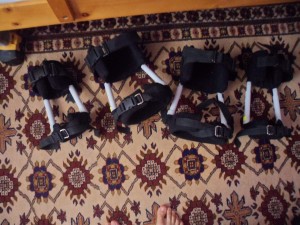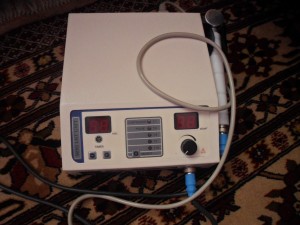Just a few days ago a person from Canada found the website and contacted me to tell me that he had obtained the machine, device, or product which Antoine from the Body Remodeling Center to use on himself. He goes by the name of Hamid. I have chosen not to reveal his last name. In the few emails we have exchanged back and forth, I was excited and asked whether he could take a few pictures of the device so I can take a look at it and also upload the pictures to a post I will write up. Well this post is to show what the device looks like.
Background
From looking at threads on the forum on MakeMeTaller.org and the website HeightQuest.com it seems that this Body Remodeling Center who’s spokesman is someone named Antoine has been around since the middle of the 2000s.
The people from the website MakeMeTaller.org has completely rejected this guy’s claims and ideas completely outright without giving the device a real long good look. For them, limb lengthening surgery is the one and only way. And maybe they are right, I still have not finished my research yet. A few people on the forum have tried contacting Antoine but they are either having trouble getting to him or he has not been responding back. I am not sure. The administrators bashed this guy enough after over 10 pages of thread posts to end it with Antoine never replying anymore to their accusations. It is a shame that they can’t be more open minded.
As for HeightQuest.com, Tyler writes on his blog post about it guessing that is a sort of bone vibrator. The actual effect is that the device causes a spiral force on the bone and cause some type of stretching force.
As he states in the post “Body Remodeling Review“…
“Antoine’s traction device may cause spiral forces on the bone and may place a stretching force on the cortical bone in that manner. Sky mentions that Antoine uses a 10 lbs traction device, which although Sky may have mentioned might have been insufficient for longitudinal stretching with severe spiral forces may be sufficient. Although it’s hard to tell without actually seeing the device in action.”
The post is short but Tyler did not like the fact that Antoine is not being more transparent in revealing more about the machine and whether it acts similarly to an ultrasonic device. It would seem however that the old website for the website BodyRemodeling.Org was taken down, maybe for financial reasons.
My Interpretation
I think when a guy comes on the boards and want to talk to the members and sell his product he probably has at least some credibility in what he says, even if they are a scammer. I wanted to see what it it that he had.
For, example, in a recent few posts I had shown that the Japanese Non-Invasive Height Increasing Machine the Ginza Kojima device was real and was credible. I had shown in the post “The Actual Patent For The Ginza Kojima Non-Invasive Limb Lengthening Height Increase Device Found, With Pictures!” that the device was real, and in the next post “A Technical Review Of The Non-Invasive Limb Lengthening Ginza Kojima Device Patent (Big Breakthrough!)” I had meticulously dissected the patent and read every part of it.
My conclusion was that the device had a maybe a 65-70% chance of actually increasing an adult person’s height by at least 1 cm. It used certain physics principles which were valid, the most unique one was the fact that the subject was spun around on a elevated table which resulted in centripetal force being created thus causing the ends of their body to slowly pull away, ie. elongate. However the height increase achieved is most likely temporary since the person’s body is only being “remodeled”. There is indeed a section of the Ginza Kojima website which suggest that the method is not really non-invasive but does require surgery. They say it explicitly on the main website.
As for the Body Remodeling Center, I had only briefly looked at the center and the claims made by Antoine in old posts like “Grow Taller Using Body Remodeling Centers, Or Not” and “Review Of Antoine El Hajj And Bone Remodeling Clinic 2008-2009, From EasyHeight.Com And MakeMeTaller.Com“. If you go back through those old posts you can see that back then what I did most of the time as just copy and paste other people’s information and not really give my personal interpretation or analysis on the devices or ideas. I was still at the beginning stages of learning the stuff.
Analysis
So is this machine/device that was promoted years ago feasible? Many people have noted that antoine never used the device on himself and he was listed at 5′ 7″ and 32 years old around the 2007 time. It is logically strange that this man would sell this product but would never try it on himself. So again there is two main parts,
This will be my last post about this device and proposed method and I will move on to research on other things.
I had said before that was two main parts….
- Bone vibrating machine – pictured in the middle
- Traction devices – what we see in the 1st and last picture.
The dial on the machine in the middle picture with the handle suggest that it is a sort of machine that emits ultrasound like what you find with nurses who use the thing on pregnant women’s stomach to see the fetus. However after checking on google on what ultrasound machines usually look like I am not really sure what that device really is in the middle.
The straps are then the traction devices. They look similar to the one picture I had in the 2nd post. Four white thick cylinders hang on the plastic straps. Each of the cylinders probably has a 10 lb (or 5 lb) weight inside so each of the four parts has a load of either 20 or 40 lbs. You can see that two of the straps is wider than the other 2 so this means that 2 of the “traction devices” are supposed to go on the thigh/upper leg part and the smaller, less wide straps go on the shin/lower leg area. The instructions from the old Body Remodeling Center’s website suggested that you needed to sleep with the 4 straps on the leg.
I guess the idea was then to let gravity to cause the extra weight of the leg to stretch the leg bones out, if they ever do. The sleeping is for extra time. The idea was that the weights when pulled down would stretch the legs out. Reasonable for common sense but for a serious height increase researcher we realize that is not reasonable.
The claim by Antoine was 4-6 cms of increase and that he offer private therapy on using the devices for $10,000-15,000. Sky had promoted this guy and it resulted in him getting more customers. From Sky’s opinion, he has concluded that Antoine’s credibility was lacking and the theoretical parts behind the technique was off.
The machine would make sense if Antoine thought that the device could emit ultrasound or some type of high intensity vibrational shockwaves. If the waves are strong enough, you can maybe demineralize the bones, remove the hard inorganic material, the calcium derived hydroxyapatite, and possibly make the hard long bones weaker in tensile load strength to make the bones weaker to pull and elongate.
So the two part proposed technique was.
- You use the machine to weaken the bone. This is similar to my proposed idea on finding the resonance frequency of the bone and induce microfractures.
- You then put on a strap that holds the top part while getting the weights attached to pull down the bone. You sleep on it so the effect is extended for many hours.
From my research I had learned that the long bones due to their hollow design make them really hard, as much as stainless steel. Adding a small 40 lbs of extra weight to each section of a leg will not be enough to cause the amount of tensile distraction needed to ever pull the leg bones longer. The idea on adding the machine is reasonable for a person who is not very involved in the science but I have never found evidence of any ultrasonic or wave inducing machine which can indeed de-mineralize or make the bones weaker.
So the pictures are below, provided by Hamid from Canada…




